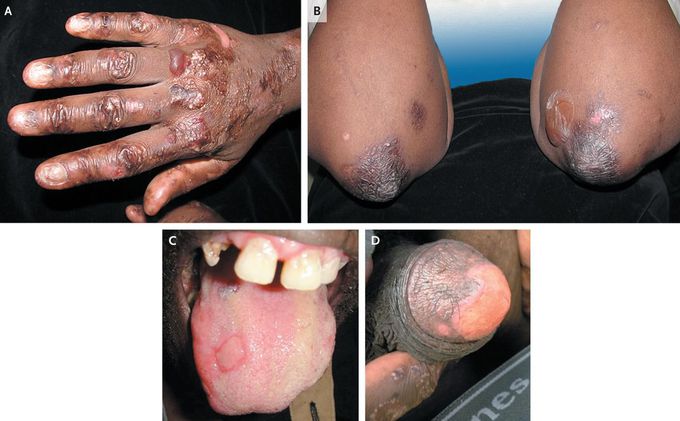


Epidermolysis Bullosa Acquisita
A 50-year-old man presented with tense noninflammatory bullae and erosions on trauma-prone areas of skin (Panels A and B) and the mucosae (Panels C and D). There was also atrophic scarring, milia formation, onychodystrophy, and anonychia. His medical history was remarkable for systemic lupus erythematosus (SLE), lupus nephritis, and hypertension. Examination of a skin-biopsy specimen revealed a cell-poor subepidermal vesicle. Direct immunofluorescence analysis revealed linear deposition of IgG at the dermal–epidermal junction. Studies of salt-split skin, which are used to examine the cutaneous basement-membrane zone for specific autoantibodies, supported the clinical suspicion of epidermolysis bullosa acquisita, an acquired subepidermal blistering disorder with autoantibodies against type VII collagen. This patient presented with the mechanobullous phenotype of epidermolysis bullosa acquisita, characterized by noninflammatory bullae that develop on trauma-prone acral skin and that heal with dyspigmentation, scarring, and milia formation. This autoimmune blistering disorder may mimic porphyria cutanea tarda, is often resistant to treatment, and may be associated with SLE. Treatment with systemic glucocorticoids, mycophenolate mofetil, and rituximab had limited benefit in this patient. Although he had a brief response to treatment with intravenous immune globulins, the administration of cyclophosphamide was started for maintenance of remission. The use of cyclophosphamide has resulted in the decreased formation of new blisters; however, disease activity has persisted.
Living with Lupus is often a battle not just against the illness itself, but also against the emotional weight of uncertainty, fatigue, and the toll of long-term medications. For one courageous woman, that battle began in 2013. Diagnosed after Lupus had already affected her joints and internal organs, she was quickly placed on medication that initially helped. But as time went on, her health declined again this time with more frequent flare-ups and increasingly difficult side effects. Like many others with chronic illness, she faced the crushing weight of hopelessness. Each day became harder than the last, and conventional treatments no longer offered the comfort they once did. But in March 2020, at her lowest point, she made a decision that changed everything.Out of desperation and with a healthy dose of skepticism she turned to NaturePath Herbal Clinic, hoping their natural Lupus treatment might offer at least some relief. What happened next went far beyond her expectations.After completing a six-month herbal program, her flare-ups stopped entirely. Her energy returned. The chronic pain that had defined her daily life began to fade. For the first time in years, she felt like herself again. Not just alive but truly living.Her story is not just one of healing; it’s one of resilience, open-mindedness, and the courage to try something new when all else fails. By sharing her journey, she hopes to offer something priceless to others living with Lupus: hope.This treatment has been a true breakthrough for her. If you’re searching for a safe, natural, and effective alternative, I genuinely recommend giving this a chance.”www.naturepathherbalclinic.com or email them at info@naturepathherbalclinic.com


